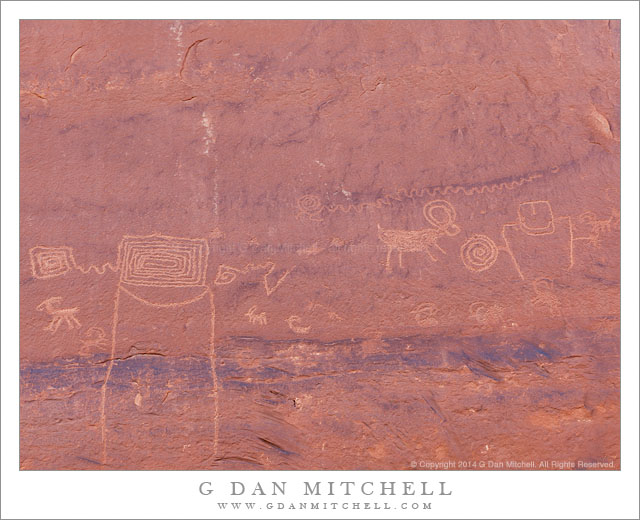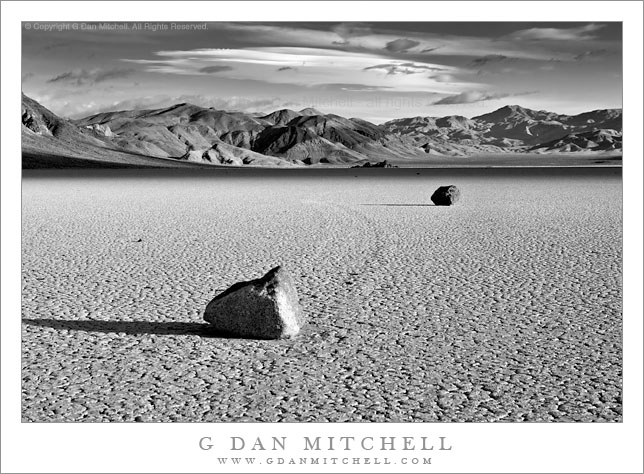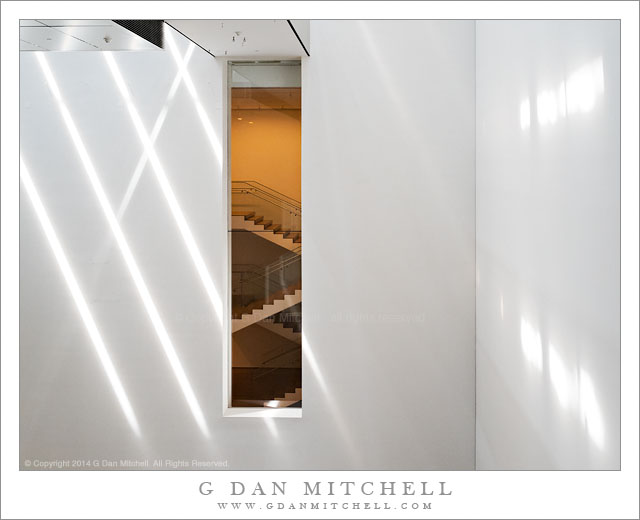
Rock Art. © Copyright 2014 G Dan Mitchell – all rights reserved.
My place is California, and within California are special locations that I have visited over a lifetime — such as “my Sierra.” Many years ago these places were new to me, and at one time the Sierra Nevada was a place of my imagination, known mostly by reading about it and looking at photographs of the highest portions of the range. Today, decades later, I do not claim to know everything about the range — that would be an impossibility! — but when I go to the Sierra most of the experiences have more of a feeling of renewing a long acquaintance than of discovering something new. The rhythms of the place are familiar, as are the details — the sounds of creeks and wind and boots on the dry trails, that light, the plants, the way that forests alternate with granite and meadows, the timberline meadows, the rugged peaks, and much more. I like to say that I have come to know particular trees and rocks.
I recently spent some time in the American Southwest with friends who know that place as well as I know mine. Visiting this area is a very different experience for me — in some ways it reminds me of when I “discovered” the Sierra so many years ago and everything was new. I see the sandstone, the canyons and arches, the pinyon pine and juniper as new and novel. There is so much to see… and so much to miss! Traveling down one small canyon with my friends I felt that I was engaged with this landscape, but soon realized that I was not seeing half of what they have learned to see. I walked down washes and saw gravel, while they saw the abundant evidence of people who had lived there long before we visited and who had left behind bits of stone tools and pottery and rock art and even their homes. Watching my friends navigate their home range made me conscious of how I know mine… and of how much I have to learn about theirs.
At one point, one of them directed us away from our main route and up a side canyon. He asked us to be sure to walk on rocks rather than sand so that we would leave no tracks — this was not a place to encourage too many others to visit. Soon we found out why. At the base of one sandstone cliff there was rock art, with its enigmatic forms and patterns. Bits of worked stone were all around in the dirt, if you knew what to look for. We found a beautiful red arrowhead, marveled at it for a moment, and then put it back. Nearby, on the other side of the canyon, was a high place where these earlier people had lived, and where we found the evidence of their presence. Before long we walked on and rejoined the main route and went about our photographic business, separating from one another as we worked different subjects.
I was alone when my turn-around time arrived late in the afternoon, and I began to walk back toward our starting point. When I came to the side canyon once again I took a quick trip back up there alone and pondered this site by myself in the early evening quiet. I thought about what it must have been like to live a life in such a place. I imagined that on an evening like this one the voices of children might have echoed across the canyon, and perhaps there might have been smells of food being prepared. And I thought about how these people must have known this place in ways that are barely comprehensible to those of us who come here today for a few days and then leave.
Morning Musings are somewhat irregular posts in which I write about whatever is on my mind at the moment. Connections to photography may be tenuous at times!
 G Dan Mitchell is a California photographer and visual opportunist whose subjects include the Pacific coast, redwood forests, central California oak/grasslands, the Sierra Nevada, California deserts, urban landscapes, night photography, and more.
G Dan Mitchell is a California photographer and visual opportunist whose subjects include the Pacific coast, redwood forests, central California oak/grasslands, the Sierra Nevada, California deserts, urban landscapes, night photography, and more.
Blog | About | Flickr | Twitter | Facebook | Google+ | 500px.com | LinkedIn | Email
Text, photographs, and other media are © Copyright G Dan Mitchell (or others when indicated) and are not in the public domain and may not be used on websites, blogs, or in other media without advance permission from G Dan Mitchell.



